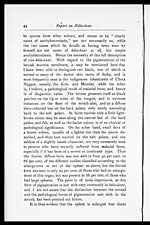Medicine - Institutions > Army health reports and medical documents > Report of an investigation of the epidemic of malarial fever in Assam, or, kala-azar > Section III - Clinical description of kala-azar
(63) Page 43
Download files
Individual page:
Thumbnail gallery: Grid view | List view

Clinical description of Kála-ázar.
43
the spleen. Thus, in the 150 cases in which the spleen was
not enlarged, only 3.33 per cent. had any enlargement of
the liver, while in the cases in which the spleen could be felt,
but did not extend as much as three fingers' breadth below
the ribs, 57.89 per cent. had some enlargement of the liver,
though in the majority of them it was not as much as one fin-
ger's breadth below the ribs; but in the cases in which the
spleen reached to three fingers or more below the ribs, in
91.65 per cent, the liver was enlarged, and in more than four-
fifths of these it extended one or more fingers' breadth be-
low the costal margin. This, it will be observed, is almost
exactly the same proportion as the liver is enlarged in kála-
ázar, so that it is evident that in this disease it is only en-
larged in proportion to the enlargement of the spleen, exactly
as it is in ordinary cases of malaria in Assam. Once more,
there is a very definite relation between the amount of fever
that the coolies had suffered from and the enlargement of
the spleen and liver, and also between these and the fre-
quency of anæmia amongst them. Thus, of the cases in
which the spleen was not enlarged, only 10 per cent. had
suffered from fever to any degree within the last two years,
and two-thirds of these had not suffered within the last year,
while 27.33 per cent. of them showed more or less anæmia,
but in two-thirds of these it was not marked. On the other
hand, of those who had slight enlargement of the organ (less
than three fingers' breadth below the ribs), 61.16 per cent.
had suffered from fever, and 55.33 were anæmic, and of those
who had marked enlargement of the organ, 75 per cent. were
anæmic, the majority of them being markedly so. It is also
worthy of note that in a good many of the anæmic cases
with enlargement of the spleen, the conjunctiva was white,
so that the conjunctiva need not necessarily be yellow
in cases of anæmia due purely to malarial fever; and the
main point which Dr. Giles relied on to differentiate
anchylostomiasis from the anæmia due to malaria, is based on
false premises, and the great majority of the cases which
G 2
Set display mode to: Large image | Zoom image | Transcription
Images and transcriptions on this page, including medium image downloads, may be used under the Creative Commons Attribution 4.0 International Licence unless otherwise stated. ![]()
| Permanent URL | https://digital.nls.uk/75014411 |
|---|




